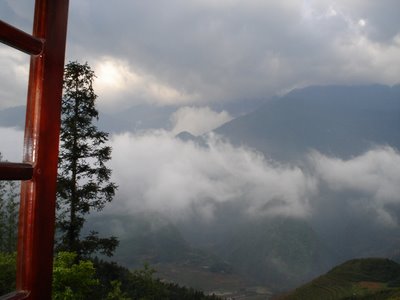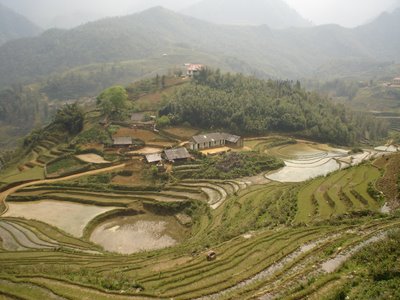 I am still not clear about the connection between the Hmong of Vietnam and the Hmong that now live in California, who I believe were from Laos. I can say that the reverse appliqué textile work that I have always associated with the groups in California, was not to be seen on my trip. What I did know was that there are several different Hmong groups; Black Hmong and Red Hmong among them.
I am still not clear about the connection between the Hmong of Vietnam and the Hmong that now live in California, who I believe were from Laos. I can say that the reverse appliqué textile work that I have always associated with the groups in California, was not to be seen on my trip. What I did know was that there are several different Hmong groups; Black Hmong and Red Hmong among them.Diem, the guy who had shown me my room, was also a tour guide. He had told me to meet him back at the main hotel entrance at 2pm for our short walk down to Cat Cat village, home of the Black Hmong. When I had asked about the tour group members, I got the usual, “I am not sure”. I soon found out it was the Vietnamese equivalent of an Elderhostel trip. I joined a group of twelve men and women, all of whom were in their 70’s and spoke no English.
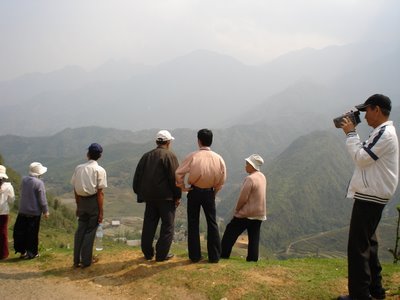
The entrance to Cat Cat was only a two minute walk down the road from the hotel. Before entering, you must pay a fee. Then you start to walk down into the valley on a winding road. Diem would stop to explain things to the group, and then translate for me. The walk was easy enough for someone fairly fit but not something one would recommend for senior citizens. Or at least not the majority of seniors in the US. However, this group of Vietnamese folks walked with as much ease and energy as I did.
I wasn’t at all sure what we would encounter. Would there be a village at the bottom? Could one buy things on the trail? I had planned to buy up as much ethnic arts and crafts as I could carry and wanted to make sure that I was able to buy directly from the people and not from a middle man at a shop.
We meandered down through terraced farm plots that grow rice once a year, then are used for corn and other vegetables. I couldn’t imagine working that land for even one hour, let alone a life time. Not far down the road, we were surrounded by tiny children selling fabric, woven bracelets. At the time, I still wasn’t sure what the protocol was for buying. It was time to invest in the community, so I bought a few. Later I was told that it wasn’t a good idea to buy from the little ones as it encouraged them to skip school in order to make money.
We passed several small structures where handicrafts were being sold. Nothing was of real interest until I saw a beautiful jacket with extensive embroidery. I stopped, as the rest of the group continued. Bao, a teenage girl, came out to me. With limited English, I ascertained that the jacket had been made by her mother. I asked the price, and it seemed more than reasonable. I ended up with it and a pair of earrings.
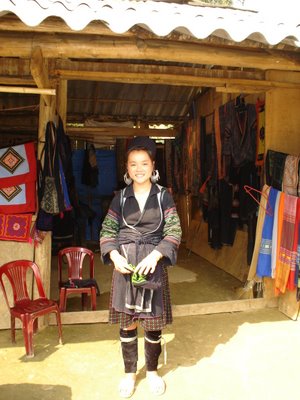
BAO
I should mention that we had been walking for over an hour and it was now quite hot and I was boiling in my two layers of shirts. Unfortunately, taking off the outer layer to reveal a tiny tank-top would not have been appropriate, especially since I was walking with a group of older Vietnamese who were totally covered against the sun. I carried on to the bottom of the hill, where we crossed a small river by way of a hanging bridge. Water buffalos, who knew what to do in the hot sun, were taking a mud bath and looking up at us with big, round, water buffalo eyes, aware of our every move.
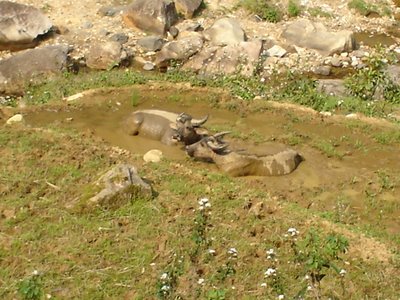
From there, it was a short walk uphill to where the motorbikes awaited us. As everyone knows, I do not do two-wheeled, motor vehicles. The tour brochure had promised transport by either jeep or motorbike. There was no jeep in sight. My options: walk straight up the 4K route back, or take a motorbike. Everyone also knows that I do not do uphill walks. With promises that my driver would go slowly and carefully, I got on. I would have preferred not to look but figured I needed to be aware of oncoming trucks or pits in the roads. I made it to the top without any trouble and only a modicum of anxiety.
Once off the motorbike, I was approached by a Hmong woman selling various items. From what I had observed, the women usually walk in groups and congregate around the tourists. When my bus first arrived in Sapa, we were beset upon by droves of young girls and women, all waving blankets and scarves and calling out for us to buy. I had already noticed that if you even took a slight interest, you were immediately surrounded by as many as ten other sellers. This woman was alone, which would allow me to really get a good look at her blankets.
I think blanket might not be the correct term. Maybe a bedspread, or a quilt top. Each piece is made of several pieces of cloth sewn together in strips with an outside border. All are different, with varying amounts of needlework, and a variety of colors. There is also some amount of machine appliqué. The woman pulled out several that she had made. All were beautiful. As I decided on which one I should get, we spoke a little. Her name was Lili, she was 30 years old and had five children. She was from the village that I would be visiting the next day. I finally decided on one with a predominately green color scheme. We thanked each other and I went to my room to take a shower before setting off to see the town.
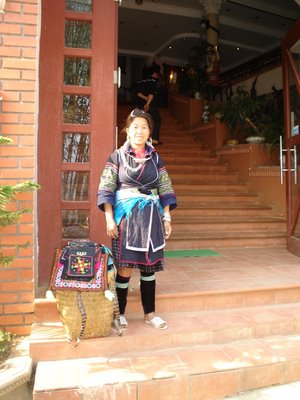
LILI
I walked up the hill towards the center of town where things flatten out for a few blocks. Stopping at the top end of an open square, I gazed out over the town to the spectacular Hoang Lien Mountain range, and Fan Si Pan Mountain, the tallest in Indochina at over 3000 meters. The top was covered in mist and I had been warned that it may remain that way my entire time in Sapa. I was told that just a few days before I arrived, the entire mountain range could not been seen because of the fog. I felt very lucky to be seeing it now with the sun slowly sinking creating a dark, jagged outline against the sky.
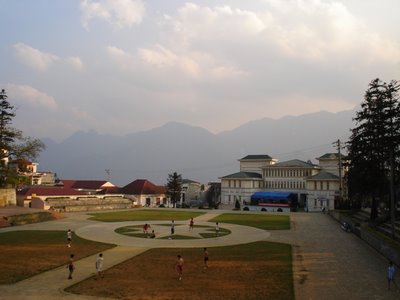
My ambling took me past another open square with stalls of venders. From a distance I could see that they were run by indigenous people and so decided to see what was on offer. I stopped at the first stall and was immediately surrounded by four beautiful girls. The first one said, “Where are you from, California?” I assumed that they, like others I have run into on this journey, had memorized a few needed sentences. But then I started talking and they answered and I realized these little ladies really did speak English.
I was quickly introduced to Ker, Zen, Lam, and Bamboo, (the translation of her name), who ranged from 12 years old to 16. They, like the other Black Hmong people I had seen, were beautiful. And Zen, at 16, was stunningly beautiful with golden brown eyes. The stall belonged to Bamboo’s mother but all the girls had things to sell. They told me they slept there at night and would return to their village every few days. I was worried that it might not be safe, but they assured me it was. Their stall was only separated by a blanket from the next one, and all the others, where adults were present, so they weren’t really alone.
Amazed at their proficiency in English, I asked them how they had learned it. From tourists, was the answer, not in school. I had already learned that all the children from the ethnic minority groups have free schooling from Vietnamese teachers. Most don’t have a written language, but they are taught Vietnamese. I never did get clear conformation as to whether or not they were taught all subjects in Vietnamese, but I believe that is the case. The girls assured me that they were still in school. It was getting dark and I wanted to take a look at the other stalls, so said I would come back a little later.

Bamboo, Lam, Ker, Zen
The girls followed me to a stall near the end where I spent a lot of time deciding on another blanket. We all walked back to their place and they asked when I would buy something from them. I said I would come back the next day when the light was better. Then Bamboo asked if I would email her. You have an email address? I asked, more than a little surprised. They all did, and went to the internet café just down the street to read their mail. Or rather to look at it. It turned out they couldn’t really read English, and when they wrote out their emails for me, in very juvenile writing, I understood why. Although they said they could read Vietnamese, I rather doubt they can do it well. Then they asked if I would go to the internet café and read their emails to them. So off we went.
None of them had any trouble navigating to either Yahoo or Hotmail. I circulated among the four, reading emails from other enamored tourists who had written how much they missed the girls and had sent pictures. They then dictated replies for me to write. When all emails had been read an answered, I paid for their time and we parted for the night, with hugs and promises to meet the next day at 4, when I should be back from the day trek.
I walked down the hill to the hotel through the clear mountain air that was a little cool, but not at all cold. Back in my room at the hotel I noticed that there were no other people there. It seemed I had Goldsea number 2, to myself. I opened the balcony and looked up at the stars and listened to the quiet. When I climbed into bed, huddled under a thick comforter, I was happy and content. The chill in the room actually felt good. Tomorrow would be a full day of trekking, although this time I would either be by myself with a guide, or with other English speakers.
My picture of the girls doesn’t do them justice, but you get the idea.
Kate
